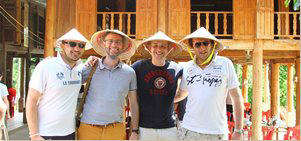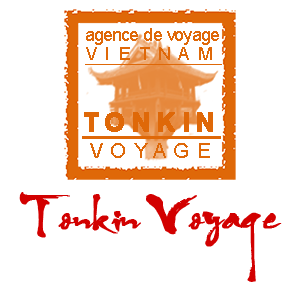Ho Chi Minh City, also named Saigon until 1975, is the largest city and the largest economic center of Vietnam
Ho Chi Minh City whose status matches that of a Vietnamese province is divided into 19 districts and 5 districts with an area of 2,090km2 and a population of 7,400,100 (2005). It lies on the banks of Saigon River, close to Mekong Delta. This city is the metropolis of the south, 1730km from Hanoi and 50km from the East Sea.
Nestled in the loop of Saigon River, Ho Chi Minh city is crisscrossed by hundreds of rivers and arroyos. It therefore has an important river network in Mekong Delta and serving until Cambodia. The climate of Ho Chi Minh City is marked by two seasons: the rainy season, from May to November brings the average annual rainfall of 1,979mm; and the dry season which lasts from December to April. The average annual temperature is around 27.55oC, winter being virtually non-existent. The climate is very pleasant and conductive to tourism throughout the year.
Ho Chi Minh City is the main industrial and economic center of Vietnam. Nearly 300,000 companies, including major companies are involved in high-technology, electronics, industrial processes, manufacturing of construction materials and agricultural machinery. The city has created a high process of domestic and foreign investment. The total investment of the private sector in the city is estimated at 160 billion VND (about US$10,000 million), with about 18,500 more lately industries. The investments focus on high technology, services and real estate projects. Currently, the city has 15 industrial parks and export processing zones outside the famous Quang Trung Software Park and Saigon Technology Park.
Saigon Port dating back from 1862 is accessible to ships weighing up to 30,000 tons; this is an unusual advantage for a port located in the interior. This port has a total of 50.5 million metric tons of cargo, representing one third of the national total.
Culture and Tourism
The first facet of Saigon (Ho Chi Minh City) which strongly impresses tourists are its size, density and dynamism. The lights on the streets, activities and entertainment lasts until nightfall. The vehicles constantly circulate in the streets. The city is filled with stores, articles of all colors and a variety whereby this city is called “Saigon – shopping paradise”. Lots of restaurants with a varied menu attract tourists.
But behind this excitement, this exciting life aligns with longstanding traditions of a culture that has adapted to early interference with other cultures of the region and the West.
Ho Chi Minh City is the vibrant center of South Vietnam. This is where the national writing, Quốc Ngữ, was popularized and has printed the first newspaper. The birth and development of the press, editions and schools, the contingent of intellectuals, literary or artistic activities and exchanges have made Saigon a large cultural influence city.
Tourism is an important economic resource for this bustling city that attracts up to 70% of visitors to the country. Moreover, in view of a constant development of tourism, the city is undertaking work of rehabilitation and restoration of historic monuments, invests in museums, preservation of traditional values through holidays and rituals, as well as in cultures of the regional orchards and horticultural villages.
Hundreds of temples to pay tribution to the founders and heroes of the country are open daily in the smoke of incense. The architecture of the old Saigon named “Pearl of the Far East” is preserved and embellished. The monuments have become very interesting sights. In addition, there are modern works inspired by the traditional architecture of Vietnam. In this densely populated city, visitors will be amazed at boulevards with large trees, parks with vibrant flowers and serene villas. In addition to the new buildings in the city center, tourists will have the opportunity to visit the Main Market of Chinese and old busier parts by commercial and manufacturing activities day and night.
Places to visit
For a complete and meaningful trip to Ho Chi Minh City, you cannot do without following attractions:
System of 11 Museums
Ho Chi Minh City brings together the largest number of museums in all other provinces of Vietnam. The works on display in museums are very varied. They represent not only the history and local culture, but also those of the entire South and Southeast Asia. It offers visitors much interesting knowledge.
- The Vietnam History Museum is the largest one, and also the first city museum dating back from the early 20th Through a continuously enlarged collection and preservation of objects, this museum now has a rich collection of nearly 30,000 valuable objects.
- The Revolution Museum where a variety of planes, helicopters and other vehicles are on display in the gardens.
- The Ho Chi Minh Museum, located in the former premises of the Incorporated Transport Company, brick building and oldest French vestige. Indeed, Saigon was the Asian terminus of the transport of passengers and freight between Marseille and the Far East during the colonial period.
Chain of temples
More than 1,000 Buddhist temples, houses and shrines built over the centuries are also cultural, artistic and architectural heritage. Here you will find typical southern pagodas, ancient temples associated with the history of the discovery of the wild land. We can also count the largest and most beautiful “innovated” temples in the country, which is the combination of traditional and modern architecture. 500,000 Chinese live in Ho Chi Minh City so the number of Chinese pagodas are the highest in the country. Many temples were recognized as historical and cultural monuments of the city and the country.
- Many pagodas that make up the city: Emperor Jade Pagoda, Giac Lam Pagoda, Vinh Nghiem Pagoda, etc.
- The Mariamman Hindu Temple on Truong Dinh Street
- The Indian mosque on Dong Du Street
- Cha Tam Church in Cho Lon Chinatown whose interior is a mixture of Gothic and Chinese. Christ is greeted by gongs.
- Chinese style temple dedicated to the goddess Thien Hau, also located in Cho Lon (Nguyen Trai Street)
French-style monuments
The French have left in Ho Chi Minh City many interesting works. We can say that there are few cities in Southeast Asia that have as many schools of Western architecture and art as Saigon. For example, the headquarters of the People’s Committee of the City was built with the style of the Third French Republic, the State Bank is influenced by the architecture of New Art, the Children’s House with the neoclassical style, Dragon House with oriental style, Notre Dame Cathedral with Romanesque…
- Notre Dame Cathedral: This church is the largest of the city that was built in 1880 and is also known as the state cathedral because the French government spent money to build it. This is also where to carry out the main ceremony and at that time, Notre Dame was regarded as the biggest in French colonies. It was made of brick and tile from Marseille with stained glass windows and steel frames made in France by combining with the green stone of Bien Hoa province. The doors are rolled to the Roman-Gothic pointed arches in the shape reminiscent of the great cathedral in Paris, Chartres and Reim.
- Tan Dinh Church: This church is smaller for the Vietnamese parish. It is the result of the mixture of different styles of the French religious architecture
- Huyen Si Church was built according to the pattern of that existing in France.
- Cha Tam Church in Cho Lon has the same shape but the interior was decorated like Chinese temples.
Cu Chi Tunnels
The most unique tourist attractions in Ho Chi Minh city are the Cu Chi tunnels. This is a unique project in the military history of the world, a symbol of the iron will and intelligence of the People’s Army of the city during the war against the Americans. All tunnels and Ben Duoc Temple on the banks of Saigon River are now a historical and cultural relic in harmony with lazy river, lush green paddy fields and orchards.
Also recognized, the Can Gio mangrove forest where there was fighting against the ships of enemy attack in the mouth of Saigon River is worth a visit. Today, this place has become a world biosphere reserve and a big ecotourism destination with endless green mangroves.
Place of interest
-
Northern Vietnam
- Where & When to visit the rice terraces in North Vietnam
- Huong Pagoda – Pilgrimage to the land of Buddhas
- Day Trips from Hanoi
- Things to do in Hanoi
- Hanoi, City of Peace
- Ninh Binh Province
- Bat Trang, ceramic art destination
- Duong Lam ancient village
- Tay Phuong Pagoda, the destination to calm down
- Cat Ba Island, World Biosphere Reserve
- Central Vietnam
- Southern Vietnam







 9th Floor, 59 Quang Trung Street, Hai Ba Trung District, Hanoi, Vietnam
9th Floor, 59 Quang Trung Street, Hai Ba Trung District, Hanoi, Vietnam  Tel: (+84) 24 3825 9988 – (+84) 24 3938 2075
Tel: (+84) 24 3825 9988 – (+84) 24 3938 2075  Email:
Email:  International Tour Operator License No. 01-531/TCDL-GP LHQT Approved by the Vietnam National Administration of Tourism
International Tour Operator License No. 01-531/TCDL-GP LHQT Approved by the Vietnam National Administration of Tourism